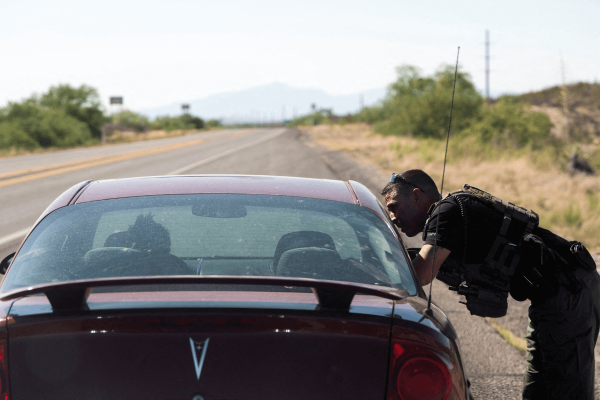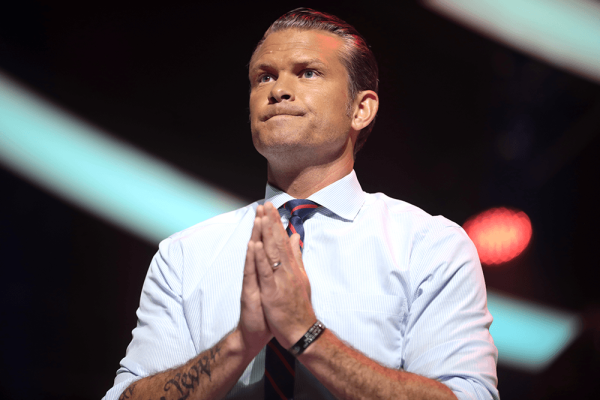This article is part of the series Faith and Migration in Swing States. New articles will be added throughout the 2024 election season.
Payson, A.Z. — Each year, Miguel makes a pilgrimage to the Yaqui Ridge in the Coronado National Memorial. Parking at the Coronado Peak trailhead, he makes his way south along the rocky trail to Border Monument 102, which marks the start of the 800-mile-long Arizona Trail, a popular recreational route stretching from the state’s southern border with Mexico to its northern terminus 30-miles from Big Water, Utah.
But Miguel is not there to hike. Instead, Miguel is there to pay homage to his mother’s journey. In 1999, she made her way across the Sonoran wilderness to reunite with the then 4-year-old Miguel and his father, who had arrived in the U.S. without documentation the year before. She never made it.
“Mom died — of starvation, dehydration, exhaustion, we don’t know — somewhere out there,” Miguel said as he looked out across a vast expanse of wilderness from atop the Yaqui Ridge and across the barbed wire fence that replaces the 30-foot bollard “wall” along this section of the border. With no knowledge of where her earthly remains may be, Border Monument 102 has become a makeshift memorial for Miguel, now 29 years old, who lives and works in Tucson. (Sojourners is withholding Miguel’s name, at his request, due to his immigration status.)
In April, Border Monument 102, and the section of the trail Miguel stood upon, experienced an increase in immigrant foot traffic according to the U.S. National Park Service. “Visitors to Coronado National Memorial have reported seeing people in camouflage near the border and on the Arizona Trail,” the USNPS said in a statement. Border crossings in the area are common, but the recent uptick in activity — and Miguel’s annual memorial journey — are reminders of the important role immigration plays in the culture, economy, politics, and religious life in the Sun Belt swing state.
‘The fear is still there’
Alongside its reignited abortion politics, its longstanding status as a frontline border state has put Arizona and its 11 electoral votes on the forefront of U.S. politics. A crucial bellwether state — eight of the past 12 presidential winners also won Arizona — the Grand Canyon State also has a tight Senate race and highly competitive House seats up for grabs in 2024.
The state’s voters have concerns about unauthorized immigration and drug trafficking on the one hand, and the adverse economic and humanitarian impact of strict border policies on the other. Arizona has had over 373,300 border encounters since Oct. 1, 2023, according to DHS data.
“Immigration, whether you live in the south of the state or the far north, is a part of life here,” said Adam Burke, a Lutheran pastor in the Arizona city of Prescott, which is between Phoenix and the northern city of Flagstaff. “Whether you see it or not,” he said, “it impacts Arizonans every day.”
That is why in poll after poll in early 2024 — like those conducted by Noble Predictive Insights, Morning Consult, and the UK-based Redfield and Wilton Strategies — immigration is, along with reproductive rights and the economy, a top issue among Arizona voters.
In Prescott, where just 5.4 percent of the population is born outside the U.S., Burke said immigration is largely invisible. “Today, walking around Prescott, it almost feels like migrants have gone around us,” he said, “but the fear is still there.”
Even so, members at Shepherd of the Hills, the predominately white church he pastors, part of the conservative Lutheran Church—Missouri Synod denomination, are visibly — and vocally — concerned about the issue. They regularly ask Burke about what he hears and sees in town: whether he has seen a “surge,” whether migrants are “causing trouble” or if they are “taking jobs,” he said, quoting his parishioners’ language.
“There’s a palpable paranoia in Prescott,” Burke said.
Faith groups in Phoenix
Elsewhere in Arizona, leaders are seeing an increase in the number of newly arrived migrants and asylum seekers but say local faith groups’ work remains largely the same.
Leah Sarat, religion professor at Arizona State University in Tempe, said a huge variety of Jewish communities, Indigenous rights organizations and churches — from Episcopalian congregations to Church of Jesus Christ of Latter-day Saints wards — in and around Phoenix have long mobilized to provide hospitality in the area. Regardless of numbers, they continue to do so today, she said.
Sarat, who worked with the now shuttered Restoration Project — which partnered with faith-based groups to build a network of support for adults being detained and those who were released in Phoenix — said local faith communities have learned much since 2014, when hundreds of undocumented migrants apprehended in Texas were flown by federal officials to Arizona and left at Greyhound bus stations in Tucson and Phoenix.
Since then, Sarat said, support for migrants has become more systematized and bureaucratic. But local faith groups are still stepping in to meet needs the government is not.
“There is definitely a concern that if things become dire at the border, there will be an impact locally in Phoenix,” she said.
The main challenge then, she said, is whether the government will pass policies and provide funding to help faith-based nonprofits do what they do best. “There is a concern about what’s going to happen if there are more bus dumps or releases on the city streets,” she said, “a concern that the network of providers won’t be able to meet the humanitarian needs of the asylum seekers in their orbit.”
In particular, Sarat mentioned needing more transparency and oversight with how the government is handling influxes of newcomers. “When working with the Restoration Project, we would see asylum seekers being treated in a way that was completely hidden from us,” she said. Because local nongovernmental organization often fill the gaps in immigrants’ needs that the government cannot meet, Sarat said NGOs would benefit from knowing what those gaps are before they pop up.
“Coming from the communities, there are a lot of resources to help asylum seekers,” she said. “We just want to make sure they get used to meet immediate needs and provide quick fixes where government bureaucracy might slow things down.”
Militarization near the border
Closer to the U.S.-Mexico border, south of Tucson, pastor Randy J. Mayer said the problem is not the number of people coming across the border, but the policies that have prioritized national security above all else.
Mayer has served at Good Shepherd United Church of Christ in Sahuarita — some 35 miles from the border — for nearly three decades. In that time, Mayer has watched immigration ebb and flow. He has also witnessed the impact of five successive presidential administrations on the Arizonan borderlands. Consistently, he said, each administration has built on its predecessors “bad policies,” he said.
“The intensity of the rhetoric changes,” he said. “But in my estimation, Congress after Congress and all these different administrations have only thrown money at Border Patrol and Homeland Security to the detriment of humanitarian efforts to provide help for those arriving at our southern border.
“Operational control seems the only goal,” Mayer said.
The result is it increasingly feels like he lives in “a war zone” — not because of “lawless migrants flooding across the desert,” as some politicians allege, but because of the increased presence of helicopters, drones, checkpoints, and other forms of government surveillance.
“It’s all feeding into people’s fear,” he said. “It’s forcing migrants to rely more and more on cartels to safely transport them across the border and limiting our ability to care for the migrants facing death, violence, and suffering in the Sonoran Desert.”
Much like in Phoenix, faith organizations in communities like Mayer’s have had to step into the gaps left by the government to provide care to those in need.
“When people crossed the border between 1998-2000, they were knocking on my church members’ doors,” Mayer said. But with expanded border defenses and increased operational presence of federal officials across Arizona’s borderlands, Mayer said he and others have had to go deeper and deeper into the wilderness to provide care.
For 19 years now, Mayer and his team of 150-250 volunteers, with a fleet of vehicles, have been putting water out on the trails and going on “searches” for desperate people who are lost, providing them with immediate humanitarian assistance.
“We’ve encountered, literally, thousands of migrants,” he said. “Just yesterday — April 24, 2024 — we encountered around 200 people.”
The situation, he said, demands better policies. And while Mayer feels fairly confident Gov. Katie Hobbs, a Democrat, will veto bills Mayer said would otherwise be “disastrous” for immigrants and those who serve them — he’s a bit nervous about how Arizonans might vote in November 2024.
“With all the fear in the media and negative political rhetoric flying around, Arizonans could end up supporting some pretty disastrous policies,” he said.
His fear is that these policies would make it even more difficult — if not impossible — for him and his volunteers to help save migrant lives. The result, he said, is that more mothers like Miguel’s will not make it through the operational gauntlet of America’s immigration defenses.
“If you come down to the borderlands, and not just to make a political stunt of it, you will see that the real humanitarian crisis is not what’s happening to Arizonans, but the terrible things that this mass of migrating people experience every day,” he said.
“The problem is few voters and politicians have this perspective,” he said. “They desperately need it to create policies that actually help.”
Otherwise, Mayer surmised, the suffering will only get worse. In the meantime, he said, “people of conscience and faith here in the borderlands will continue following the example of Jesus, going out to the margins to care for others.”
“We can’t just sit around and wait for people and politicians to make better choices,” he said. “We have to go out in the wilderness, because people are dying in our backyard.”
Got something to say about what you're reading? We value your feedback!





